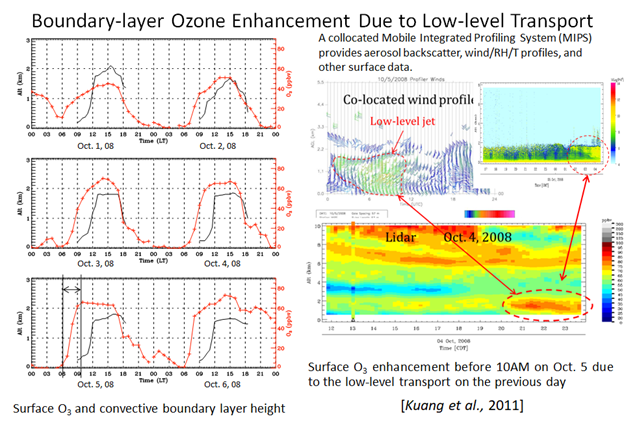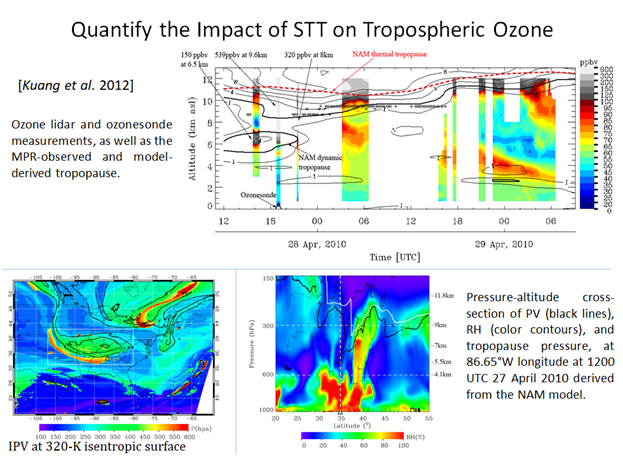OZONE TRANSPORT
The O3 transport in which we are interested includes both the air pollutant (O3 and its precursors, primarily NOx, CO, and VOCs) transport/transformation from a high emission region to the downwind area and the stratosphere-to-troposphere transport (STT) which is entirely a nature source for tropospheric O3. The spatial scale of O3 transport is typically regional and, however, could be transcontinental, even global.
One of our previous study was conducted focusing on an enhancement in the nocturnal residual layer which was observed by the UAH RO3QET lidar from the late evening to midnight on 4 October 2008. The well-correlated O3, aerosol, water vapor, and wind structures suggested a low-level jet was responsible for this O3 enhancement. HYSPLIT backward trajectories supported this conclusion with southerly transport suggesting Birmingham, AL as the source. Correspondingly, the higher increasing rate of surface O3 observed on the morning of 5 October can be explained by the entrainment into the mixed layer of higher O3 aloft on this day as compared with 4 October. The mechanism contributing to the formation of this LLJ is likely the boundary layer forcing when the airflow near the top of the nocturnal boundary decouples from the surface friction especially under a stable atmosphere condition. This case study demonstrated the importance of continuous high-resolution lidar profiling for capturing short-duration O3 variations in the lower troposphere.

STT, which hereafter refers to only downward motion of the stratosphere-to-troposphere exchange (STE), makes an important contribution (at least 10%) to the budget of tropospheric O3 although the debate about its quantitative significance continues. In North America, STT occurs mostly frequently in the midlatitudes between 40oN and 65oN, however, its impact is mostly confined to the subtropical lower troposphere (maximized at 30-40oN) due to quasi-isentropic descent. Deep STT events are often found in the midlatitude storm track regions associated with baroclinic activities, such as tropopause folding and cutoff cyclones, and account for ~15% of the total STT mass flux during winter. Most of the STT contributes to the tropospheric budget through a shallow and transient exchange. However, those deep STT events significantly change the oxidizing capacity of the troposphere and even enhance the surface maxima. In terms of the seasonal cycle, the maximum net downward cross tropopause transport of O3 occurs in spring despite the comparable net downward air mass flux in winter and spring. STT plays a considerably important role for the spring maximum of the background O3 in the North Hemisphere.
An example in the following figure shows the tropospheric O3 structures under a springtime STT event measured at Huntsville, AL by the RO3QET lidar on 27-29 April 2010 and the corresponding potential vorticity (PV) analysis derived from the North American Mesoscale (NAM) model. The STT event was associated with an upper-air cutoff cyclone and tropopause fold. In this case, the tropopause reached 6 km and the STT resulted in a 2-km thick elevated O3 layer with values between 70 and 85 ppbv descending from the ~306-K to 298-K isentropic surface.

REFERENCES
Kuang, S., M. J. Newchurch, J. Burris, L. Wang, K. Knupp, and G. Huang (2012), Stratosphere-to-troposphere transport revealed by ground-based lidar and ozonesonde at a midlatitude site, J. Geophys. Res., 117, D18305, doi:10.1029/2012JD017695. PDF link
Kuang, S., M. J. Newchurch, J. Burris, L. Wang, P. Buckley, S. Johnson, K. Knupp, G. Huang, and D. Phillips (2011), Nocturnal ozone enhancement in the lower troposphere observed by lidar, Atmos. Environ., 45, 6078-6084, doi:10.1016/j.atmosenv.2011.07.038. PDF Link
|